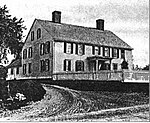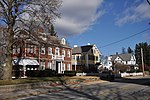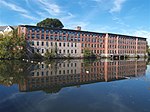Peleg Arnold Tavern
1690 establishments in Rhode IslandCommercial buildings on the National Register of Historic Places in Rhode IslandDrinking establishments on the National Register of Historic Places in Rhode IslandHistoric district contributing properties in Rhode IslandHouses completed in 1690 ... and 9 more
Houses in Providence County, Rhode IslandHouses on the National Register of Historic Places in Rhode IslandNRHP infobox with nocatNational Register of Historic Places in Providence County, Rhode IslandNorth Smithfield, Rhode IslandProvidence County, Rhode Island Registered Historic Place stubsTaverns in Rhode IslandTaverns in the American RevolutionUse mdy dates from August 2023

The Peleg Arnold Tavern off Great Road in Union Village in North Smithfield, Rhode Island was built around 1690 and is one of the oldest homes in North Smithfield. The oldest part of house was built in the late 17th century by Richard Arnold, one of the earliest settlers in the area. His descendant, Peleg Arnold, greatly expanded the building a century later. Peleg Arnold was a justice of the Rhode Island Supreme Court and representative to the Continental Congress. Arnold's popular tavern served as center of American military operations in the town during the American Revolution. The house was added to the National Register of Historic Places in 1974.
Excerpt from the Wikipedia article Peleg Arnold Tavern (License: CC BY-SA 3.0, Authors, Images).Peleg Arnold Tavern
Woonsocket Hill Road,
Geographical coordinates (GPS) Address Nearby Places Show on map
Geographical coordinates (GPS)
| Latitude | Longitude |
|---|---|
| N 41.989166666667 ° | E -71.533888888889 ° |
Address
Woonsocket Hill Road 30
02896
Rhode Island, United States
Open on Google Maps











